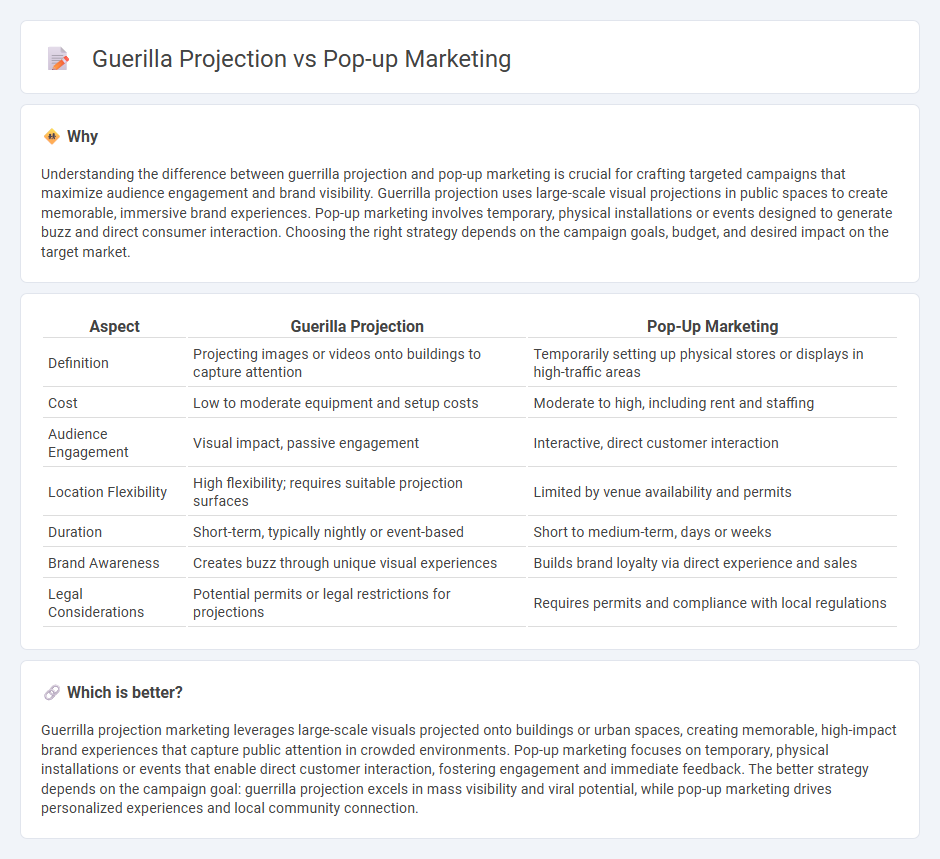
Guerrilla projection marketing utilizes large-scale imagery or messages projected onto buildings and public spaces to capture attention in high-traffic areas, creating memorable visual experiences. Pop-up marketing involves temporary, immersive physical spaces or events designed to engage consumers directly and foster brand interaction within short timeframes. Explore more strategies to maximize brand impact through innovative marketing approaches.
Why it is important
Understanding the difference between guerrilla projection and pop-up marketing is crucial for crafting targeted campaigns that maximize audience engagement and brand visibility. Guerrilla projection uses large-scale visual projections in public spaces to create memorable, immersive brand experiences. Pop-up marketing involves temporary, physical installations or events designed to generate buzz and direct consumer interaction. Choosing the right strategy depends on the campaign goals, budget, and desired impact on the target market.
Comparison Table
| Aspect | Guerilla Projection | Pop-Up Marketing |
|---|---|---|
| Definition | Projecting images or videos onto buildings to capture attention | Temporarily setting up physical stores or displays in high-traffic areas |
| Cost | Low to moderate equipment and setup costs | Moderate to high, including rent and staffing |
| Audience Engagement | Visual impact, passive engagement | Interactive, direct customer interaction |
| Location Flexibility | High flexibility; requires suitable projection surfaces | Limited by venue availability and permits |
| Duration | Short-term, typically nightly or event-based | Short to medium-term, days or weeks |
| Brand Awareness | Creates buzz through unique visual experiences | Builds brand loyalty via direct experience and sales |
| Legal Considerations | Potential permits or legal restrictions for projections | Requires permits and compliance with local regulations |
Which is better?
Guerrilla projection marketing leverages large-scale visuals projected onto buildings or urban spaces, creating memorable, high-impact brand experiences that capture public attention in crowded environments. Pop-up marketing focuses on temporary, physical installations or events that enable direct customer interaction, fostering engagement and immediate feedback. The better strategy depends on the campaign goal: guerrilla projection excels in mass visibility and viral potential, while pop-up marketing drives personalized experiences and local community connection.
Connection
Guerrilla projection and pop-up marketing both leverage unexpected, temporary displays in high-traffic areas to capture consumer attention and create memorable brand experiences. These tactics prioritize low-cost, high-impact visuals that disrupt traditional advertising methods, fostering engagement through surprise and novelty. By utilizing urban spaces creatively, they generate buzz and amplify brand visibility in ways that conventional marketing often cannot.
Key Terms
Pop-up Marketing:
Pop-up marketing creates temporary retail spaces or events designed to engage consumers directly and boost brand exposure through immersive experiences and limited-time offers. This strategy leverages foot traffic and social interaction, fostering immediate customer engagement and higher conversion rates. Explore how pop-up marketing can transform your brand's reach and customer connection.
Temporary Retail
Pop-up marketing leverages short-term retail spaces to create immersive brand experiences that drive immediate consumer engagement and sales, often utilizing high foot traffic locations for maximum visibility. Guerilla projection uses dynamic, large-scale light projections on urban surfaces to capture attention and create buzz without the need for physical storefronts, offering a flexible and cost-effective alternative to traditional temporary retail setups. Explore the unique advantages and creative applications of these innovative strategies to boost your brand presence.
Experiential Engagement
Pop-up marketing creates immersive, temporary retail spaces to engage consumers directly, fostering hands-on brand interactions and memorability. Guerilla projection uses urban surfaces for unexpected, large-scale visual displays, capturing attention through surprise and public spectacle. Explore how these innovative tactics elevate experiential engagement and drive brand resonance in diverse environments.
Source and External Links
What Is Pop-up Marketing and How Do You Use It? - Indeed - Pop-up marketing uses quick, temporary touchpoints--like website promotions or physical pop-up shops--to widen a brand's sales funnel and engage new customers.
How To Maximize Your Pop-up Marketing Strategy (+ Examples) - Sendlane - Effective pop-up marketing examples include offering first-time visitor discounts, promoting newsletters, and using interactive pop-ups to boost engagement and conversions on websites.
The Rise of Pop-Up Experiences: A Guide to Marketing Success - Attack Marketing - Pop-up experiences are immersive, temporary events that create buzz, foster genuine customer interactions, and drive urgency through face-to-face engagement.
 dowidth.com
dowidth.com